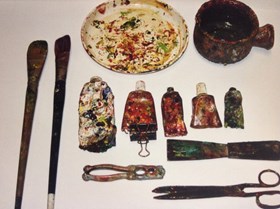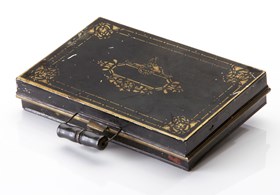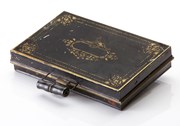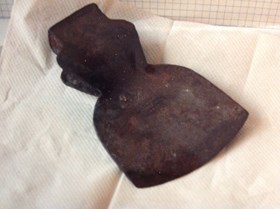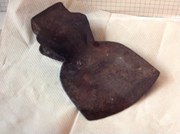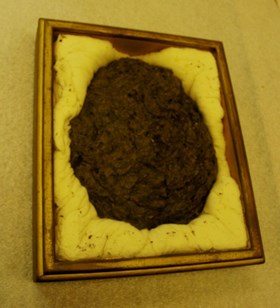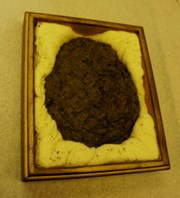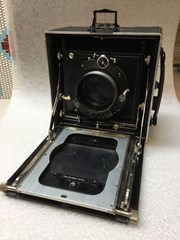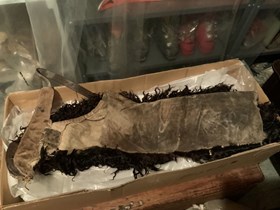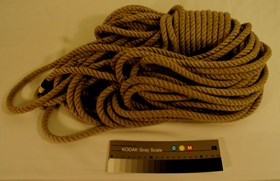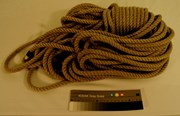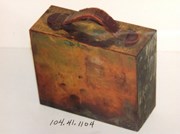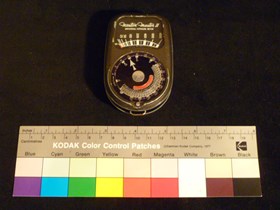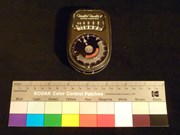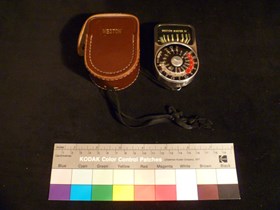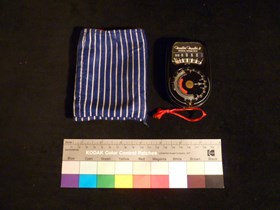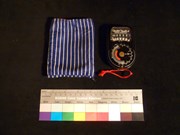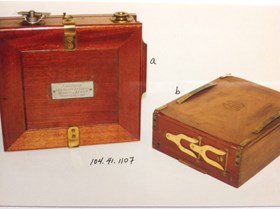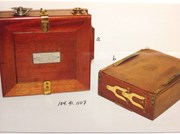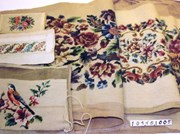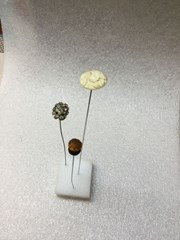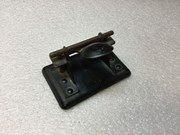Narrow Results By
Artist Assemblage
https://archives.whyte.org/en/permalink/artifact104.39.1019
- Date
- 2001 – 2003
- Material
- paint; plastic; fibre; metal; wood; ceramic
- Catalogue Number
- 104.39.1019
- Description
- Collection of painting tools including: an apron; 2 paint brushes; 2 plastic plates; a ceramic bowl; a nutcracker; a pair of scissors; a pallette knife; a plaster knife; and 5 cut paint tubes. All pieces are covered in oil paint.
1 image
- Title
- Artist Assemblage
- Date
- 2001 – 2003
- Material
- paint; plastic; fibre; metal; wood; ceramic
- Dimensions
- 61.0 (apron) x 79.0 (apron) cm
- Description
- Collection of painting tools including: an apron; 2 paint brushes; 2 plastic plates; a ceramic bowl; a nutcracker; a pair of scissors; a pallette knife; a plaster knife; and 5 cut paint tubes. All pieces are covered in oil paint.
- Subject
- crafts
- painting
- Maureen Fair
- flowers
- Credit
- Gift and purchased from Maureen Fair, Canmore, 2002
- Catalogue Number
- 104.39.1019
Images
This material is presented as originally created; it may contain outdated cultural descriptions and
potentially offensive content.
Read more.
- Date
- 1880 – 1939
- Material
- metal; wood
- Catalogue Number
- 104.39.1003
- Description
- A small black japanned tin with a wooden handle. The tin contains a wooden palette along with brushes and oil paint tubes.
1 image
- Title
- Artist Box
- Date
- 1880 – 1939
- Material
- metal; wood
- Description
- A small black japanned tin with a wooden handle. The tin contains a wooden palette along with brushes and oil paint tubes.
- Subject
- Mary Schaffer
- artists
- painting
- Credit
- Gift of Charles C. Reid, Banff, Alberta, 1978
- Catalogue Number
- 104.39.1003
Images
This material is presented as originally created; it may contain outdated cultural descriptions and
potentially offensive content.
Read more.
- Date
- 1880 – 1950
- Material
- metal
- Catalogue Number
- 104.21.1004
- Description
- Axe head marked “4” and “Gilpin.”
1 image
- Title
- Axe
- Date
- 1880 – 1950
- Material
- metal
- Description
- Axe head marked “4” and “Gilpin.”
- Subject
- households
- Credit
- Gift of Unknown, 1968
- Catalogue Number
- 104.21.1004
Images
This material is presented as originally created; it may contain outdated cultural descriptions and
potentially offensive content.
Read more.
- Date
- 2001
- Material
- metal
- Catalogue Number
- 103.01.1040
- Description
- A simple flat copper bracelet folded under .50cm at each end. “HELEN LOVE GEORGE” is crudely engraved on the outside middle.
1 image
- Title
- Bracelet
- Date
- 2001
- Material
- metal
- Dimensions
- 2.0 x 17.7 cm
- Description
- A simple flat copper bracelet folded under .50cm at each end. “HELEN LOVE GEORGE” is crudely engraved on the outside middle.
- Subject
- households
- adornment
- Credit
- Gift of anonymous, 2001
- Catalogue Number
- 103.01.1040
Images
This material is presented as originally created; it may contain outdated cultural descriptions and
potentially offensive content.
Read more.
- Date
- 1881
- Material
- grass; wood; paper; glass; metal;
- Catalogue Number
- 112.02.1005
- Description
- A framed (in a gold-coloured shadow box with a screwed-on wooden back) and glassed-in mound of bison dung surrounded by white tissue paper. There is a screwed-in hook at the top of the box for hanging. Au verso written in pen “THIS 100% PURE BUFFALO CHIP WAS CREATED ON THE PLAINS OF ALBERTA - ABOU…
1 image
- Title
- Buffalo Dung
- Date
- 1881
- Material
- grass; wood; paper; glass; metal;
- Dimensions
- 24.0 (frame 34.0) x 20.0 (frame 29.0) cm
- Description
- A framed (in a gold-coloured shadow box with a screwed-on wooden back) and glassed-in mound of bison dung surrounded by white tissue paper. There is a screwed-in hook at the top of the box for hanging. Au verso written in pen “THIS 100% PURE BUFFALO CHIP WAS CREATED ON THE PLAINS OF ALBERTA - ABOUT 30 MILES S-E OF RED DEER - ON OR ABOUT THE 24TH DAY OF JULY 1881 - PRESERVED BY THE KINDNESS OF THE ABERHART GOVERNMENT”. Signed in pencil in script “Pat Lawrence P-L Ranches Red Deer”. On viewer’s left there is a white rectangular paper sticker with a red border, above this printed in pen “CERTIFIED GENUINE” and written on the paper, extending onto the wood, a signature in pen ESMeaueug?? underlined.
- Subject
- plants
- feces
- buffalo
- Nick Morant
- Credit
- Gift of Nicholas Morant, Banff, 2006
- Catalogue Number
- 112.02.1005
Images
This material is presented as originally created; it may contain outdated cultural descriptions and
potentially offensive content.
Read more.
- Date
- 1885 – 1890
- Material
- wood; metal; skin
- Catalogue Number
- 104.41.1010 a,b
- Description
- “Premo D” folding camera (4”x5” format) with a leather covered wooden frame. The camera has a leather handle centred on the top and held in place with brass keepers. The hinged front of the camera opens to lie flat and has a brass track (3.2 cm wide) running down the centre. The red leather bell…
1 image
- Title
- Camera
- Date
- 1885 – 1890
- Material
- wood; metal; skin
- Dimensions
- 12.0 x 14.5 x 17.5 cm
- Description
- “Premo D” folding camera (4”x5” format) with a leather covered wooden frame. The camera has a leather handle centred on the top and held in place with brass keepers. The hinged front of the camera opens to lie flat and has a brass track (3.2 cm wide) running down the centre. The red leather bellows extend along the track and end with a wooden frame that holds a lens (missing) and a viewfinder. The camera also has hinged doors on the right side and on the back.b) Film plate holder loaded in the camera’s side chamber.
- Subject
- households
- photography
- hobbies
- Credit
- Gift of Unknown, 1968
- Catalogue Number
- 104.41.1010 a,b
Images
This material is presented as originally created; it may contain outdated cultural descriptions and
potentially offensive content.
Read more.
- Date
- 1889 – 1945
- Material
- metal; glass; leather;
- Catalogue Number
- 104.41.0181
- Description
- Black leather and silver metal 4x6 Curt Bentzin Görlitz camera with a fold-down front panel that exposes the lens and bellows, a leather handle and two adjustment knobs on one side, a pop-up view finder on top, and fold-out leather flaps that access the exposure plate. Small metal levers throughout…
1 image
- Title
- Camera
- Date
- 1889 – 1945
- Material
- metal; glass; leather;
- Dimensions
- 19.7 x 20.0 x 14.4 cm
- Description
- Black leather and silver metal 4x6 Curt Bentzin Görlitz camera with a fold-down front panel that exposes the lens and bellows, a leather handle and two adjustment knobs on one side, a pop-up view finder on top, and fold-out leather flaps that access the exposure plate. Small metal levers throughout allow different panels in the camera to open - three holes along the bottom [one on the body of the camera and two on the fold-down lens plate] allow the camera to be mounted on a tripod.
- Subject
- Crosby family
- Abegweit
- cameras
- photography;
- Credit
- Gift of Robert Crosby Family, Banff, 1998
- Catalogue Number
- 104.41.0181
Images
This material is presented as originally created; it may contain outdated cultural descriptions and
potentially offensive content.
Read more.
- Date
- 1883 – 1926
- Material
- cardboard; metal; glass;
- Catalogue Number
- 104.41.0129 a,b
- Description
- Two camera lenses housed in a repurposed Hammond box with “OLD ‘ADON’ Telephoto in shutter circa 1990’s” written in black ink on the front.The larger lens with shutter was manufactured by Bausch & Lomb Optical Co., originally a company that produced prescription eye-wear in the mid to late-1800s be…
1 image
- Title
- Camera Lenses
- Date
- 1883 – 1926
- Material
- cardboard; metal; glass;
- Dimensions
- 5.7 x 7.8 x 14.5 cm
- Description
- Two camera lenses housed in a repurposed Hammond box with “OLD ‘ADON’ Telephoto in shutter circa 1990’s” written in black ink on the front.The larger lens with shutter was manufactured by Bausch & Lomb Optical Co., originally a company that produced prescription eye-wear in the mid to late-1800s before expanding into camera lenses and microscopes/telescopes towards the turn of the century. The company was founded in Rochester NY.The smaller lens was manufactured by Gundlach-Manhattan Optical Co., a merged company between Gundlach Optical Co. and Manhattan Optical Co. that took place in 1902, which produced various kinds of bellows cameras. Both companies were based in Rochester NY prior to merging.
- Credit
- Gift of Nicholas Morant, Banff, 2006
- Catalogue Number
- 104.41.0129 a,b
Images
This material is presented as originally created; it may contain outdated cultural descriptions and
potentially offensive content.
Read more.
- Date
- 1880 – 1900
- Material
- skin
- Catalogue Number
- 103.05.3012
- Description
- Tag attached: “chaps anorga black Archie Daniels 1890s.”
1 image
- Title
- Chaps
- Date
- 1880 – 1900
- Material
- skin
- Description
- Tag attached: “chaps anorga black Archie Daniels 1890s.”
- Credit
- Gift of Catharine Robb Whyte, O. C., Banff, 1979
- Catalogue Number
- 103.05.3012
Images
This material is presented as originally created; it may contain outdated cultural descriptions and
potentially offensive content.
Read more.
- Date
- 2004
- Material
- fibre; plastic; glue
- Catalogue Number
- 108.04.1154
- Description
- A grey fibre rope, coiled, wrapped round, and tied with a butterfly coil knot. The rope is kept from fraying and coming apart by secured ends with white adhesive tape on the tips, and black duct tape above that.
1 image
- Title
- Climbing Rope
- Date
- 2004
- Material
- fibre; plastic; glue
- Dimensions
- 1.50 x 105.0 cm
- Description
- A grey fibre rope, coiled, wrapped round, and tied with a butterfly coil knot. The rope is kept from fraying and coming apart by secured ends with white adhesive tape on the tips, and black duct tape above that.
- Credit
- Gift of Bridget Jones, 2009
- Catalogue Number
- 108.04.1154
Images
This material is presented as originally created; it may contain outdated cultural descriptions and
potentially offensive content.
Read more.
Cut-Film Holder
https://archives.whyte.org/en/permalink/artifact104.41.1104
- Date
- 1885 – 1900
- Material
- metal; skin
- Catalogue Number
- 104.41.1104
- Description
- Metal box with opening compartments and leather carrying handle marked “45”. “Pat. May 31. 87. Aug. 3. 90” stamped on top. Spring loaded film changing apparatus inside.
1 image
- Title
- Cut-Film Holder
- Date
- 1885 – 1900
- Material
- metal; skin
- Dimensions
- 4.5 x 11.5 cm
- Description
- Metal box with opening compartments and leather carrying handle marked “45”. “Pat. May 31. 87. Aug. 3. 90” stamped on top. Spring loaded film changing apparatus inside.
- Subject
- photography
- Vaux family
- Credit
- Gift of Molly Vaux, New York, USA, 1999
- Catalogue Number
- 104.41.1104
Images
This material is presented as originally created; it may contain outdated cultural descriptions and
potentially offensive content.
Read more.
Exposure Meter
https://archives.whyte.org/en/permalink/artifact104.41.1118
- Date
- 1888
- Material
- metal; paint; plastic
- Catalogue Number
- 104.41.1118
- Description
- Hand held exposure/light meter made by Weston Electrical Instrument Company in a grey metal finish. Along both sides of the meter are a series of protruding lines that allow one to safely grip the object. At the bottom of the artifact there is a metal hook, which would have allowed a string to be a…
1 image
- Title
- Exposure Meter
- Date
- 1888
- Material
- metal; paint; plastic
- Dimensions
- 2.0 x 6.0 x 9.5 cm
- Description
- Hand held exposure/light meter made by Weston Electrical Instrument Company in a grey metal finish. Along both sides of the meter are a series of protruding lines that allow one to safely grip the object. At the bottom of the artifact there is a metal hook, which would have allowed a string to be attached like on the other Weston meter’s owned by Nicholas. There is also no longer a case to protect this particular object. In the top of the exposure meter there is a clear plastic covering. Along the very top there us the name of the manufacturer in white cursive lettering that reads “Weston Master II” and written underneath in capital letters “UNIVERSAL EXPOSURE METER.” Below this is the light scale where the value of the scene would be indicated. The scale contains the values “0” “25” “50” “100” “200” “400” “800” “1600,” which means that the two values on this instrument are calibrated 0-50 and 0-1600. (candles per square foot.)Below there is a circular face with several figures and a dial that turns/rotates. The outside row of figures on the exposure control dial represents the light value settings and corresponds to the light values on the light scale. Below the round dial there is a tiny circular button that is used to set the exposure control dial for film speed. As the dial turns it reveals the “EMULSION SPEED” with a red baize finish that has become worn throughout its life. The row of figures at the bottom of the top dial is the f/stop values and has an “f” to make this more apparent for the user. The row of figures directly below the f/stop settings are the shutter speeds. After setting the exposure control dial to the light value obtained on the light scale, any of the combinations of f/stop and shutter speed directly opposite each other are correct. On the rear of the meter there is a black plastic covering that contains several circular cut outs that are called a hir.ged baffle. This can be swung open (against the case) using the gold latch, which clips into a tiny hole or socket when the user wishes it to be closed. When opened the light sensitive photo cell is directly beneath this baffle and contains several protruding circles. When the baffle is open, the scale range is 0-50; when the baffle is closed, the scale range is 0-1600. Below there is an oval shaped face with extensive information that is held in place with two small screws on both the viewer left and right side. There is silver lettering on a black background that reads “WESTON ELEC. INST. CORP.” “NEWARK, N.J., U.S.A.” A silver backing separates the patent information and has black writing that reads “MODEL 735” on the viewer left side. On the viewer right side the number “7454510” is engraved. In the middle there is a gold-coloured screw with the words “ZERO CORRECTOR” written in black. Below this there is the patent information; “U.S. PATENTS” “2,274,441” “2,073,790” “2,346,555” “2,137,466” “2,463,770.” Below these numbers are the “FOREIGN PATENTS” “FRENCH 862,770” “BRITISH 531,996” “CAN. 347,085” “CAN. 411,975” At the very bottom underneath there is the manufacturer’s location; “MADE IN U.S.A.”
- Subject
- photography
- Nick Morant
- Credit
- Gift of Nicholas Morant, Banff, 2006
- Catalogue Number
- 104.41.1118
Images
This material is presented as originally created; it may contain outdated cultural descriptions and
potentially offensive content.
Read more.
- Date
- 1888
- Material
- leather; metal; nylon; plastic; thread; paint
- Catalogue Number
- 104.41.1119 a-b
- Description
- Hand held light meter in a pear shape with a stainless steel body and leather case. Along both sides of the meter are a series of protruding lines that allow one to safely grip the object. On the viewer right there is a pointer lock, which is locked when positioned upwards and released when positio…
1 image
- Title
- Exposure Meter
- Date
- 1888
- Material
- leather; metal; nylon; plastic; thread; paint
- Dimensions
- 2.0 x 5.0 x 9.0 cm
- Description
- Hand held light meter in a pear shape with a stainless steel body and leather case. Along both sides of the meter are a series of protruding lines that allow one to safely grip the object. On the viewer right there is a pointer lock, which is locked when positioned upwards and released when positioned downward. At the bottom of the artifact there is a metal hook, which has a black string running through. In the top of the light meter there is clear plastic covering. Written in capital letters is “WESTON MATER IV” above the light scale. The lights scale contains the numbers “0” “25” “50” “100” “200” “400” “800” “1600,” which means that the 2 values calibrated on this instrument are 0-50 and 0-1600.Below there is another light scale in the form of a circular face with several figures and a dial that turns/rotates. The dial on the outside has a series of protruding lines to make movement easier and contains a row of figures. This dial controls the lens aperture (f/stop) scale and has a series of values representing the focal length of the lens; “1” “1.4” “2” “2.8” “4” “5.6”. On the same dial there is also the letters “EVS,” which stands for the exposure value setting with a cut out window that reveals the EVS values. Working in a clockwise direction (on the same dial) there is also the letters “U,” “A with “1/2” over top,” an enclosed arrow that is known as the normal arrow, a “C” with “2x” on top of it, and a “0”. As this dial is turned it reveals a partly red baize and black numbers on a silver background that represents the shutter speeds in fractions of seconds. The inside dial has a series of light scale values and an exposure index window that line up with the “U,” “A,” normal arrow, “C,” and “0.” On the opposite side of the exposure index window is the exposure index knob. On the rear of the meter there is a black plastic covering that contains several circular cut outs that are called a hir.ged baffle. This can be swung open (against the case) using the gold latch, which clips into a tiny hole or socket when the user wishes it to be closed. When opened the light sensitive photo cell is directly beneath this baffle and contains several protruding circles. When the baffle is open, the scale range is 0-50; when the baffle is closed, the scale range is 0-1600. Below there is an oval shaped face with extensive information that is held in place with two small screws on both the viewer left and right side. There is black lettering on a silver background that reads “UNIVERSAL EXPOSURE METER” “MODEL 745” SER.W” and “107522” engraved. Below the manufacturer information is listed; “DAYSTROM. INCORPORATED” “WESTON INSTRUMENTS DIVISION”. “NEWARK. N.J.. U.S.A.” In the middle there is a gold-coloured screw with the words “ZERO CORRECTOR” written in black. On the viewer left side of the zero corrector there is patent information; “U.S. PATENTS” “2463770” and on the viewer right side “FOREIGN PATS” “CAN. 411975”. At the very bottom on either side of a circular cut out are “ASA” and “K=1.0” written. Underneath “MADE IN JAPAN” has also been written.There is also a brown leather case with this object. The front has “WESTON” written in gold letters. On the viewer left there is a brown button that allows the case to be opened or fastened shut. The leather has been stitched together with light brown thread that is visible. The bottom of the case has an opening for the black string to be strung through so that the light meter and case are attached. On the rear there is a brown leather strap stitched.
- Subject
- photography
- Nick Morant
- Credit
- Gift of Nicholas Morant, Banff, 2006
- Catalogue Number
- 104.41.1119 a-b
Images
This material is presented as originally created; it may contain outdated cultural descriptions and
potentially offensive content.
Read more.
- Date
- 1888
- Catalogue Number
- 104.41.1120 a-b
- Description
- Hand held light meter in a pear shape with a stainless steel body and leather case. Along both sides of the meter are a series of protruding lines that allow one to safely grip the object. At the bottom of the artifact there is a metal hook, which has a red string running through.There is a clear p…
1 image
- Title
- Exposure Meter
- Date
- 1888
- Description
- Hand held light meter in a pear shape with a stainless steel body and leather case. Along both sides of the meter are a series of protruding lines that allow one to safely grip the object. At the bottom of the artifact there is a metal hook, which has a red string running through.There is a clear plastic covering located at the top of the meter. Written in cursive letters is the company name “WESTON MATER II”. Underneath this written in capital letters is “UNIVERSAL EXPSOURE METER”. The light scale underneath contains the numbers “0” “25” “50” “100” “200” “400” “800” “1600,” which means that the 2 values calibrated on this instrument are 0-50 and 0-1600. Underneath the scale the word “Light” is present. Below there is another light scale in the form of a circular face with several figures and a dial that turns/rotates. The outside row of figures on the exposure control dial represents the light value settings and corresponds to the light values on the light scale at the top. The row of figures at the bottom of the top dial is the f/stop values and has an “f” to make this more apparent for the user.. On the same dial there is silver letters that have a line that correspond to the figures on the outside dial; “U,” “A with “1/2” underneath,” an arrow that is known as the normal arrow, a “C” with “2x” below it, and a “0”. As this dial is turned it reveals a partly red baize and the emulsion speed, which is self-evident as the words “EMULSION SPEED” are present. The row of figures directly below the f/stop settings are the shutter speeds. The outside row of figures is the light values, which is apparent as the word “LIGHT” with an arrow points to these values. After setting the exposure control dial to the light value obtained on the light scale, any of the combinations of f/stop and shutter speed directly opposite each other are correct. Below the round dial there is a tiny circular button that is used to set the exposure control dial for film speed.On the rear of the meter there is a black plastic covering that contains several circular cut outs that are called a hir.ged baffle. This can be swung open (against the case) using the gold latch, which clips into a tiny hole or socket when the user wishes it to be closed. When opened the light sensitive photo cell is directly beneath this baffle and contains several protruding circles. When the baffle is open, the scale range is 0-50; when the baffle is closed, the scale range is 0-1600. Below there is an oval shaped face with extensive information that is held in place with two small screws on both the viewer left and right side. There is silver lettering on a black background that reads “WESTON ELEC. INST. CORP.” “NEWARK, N.J., U.S.A.” A silver backing separates the patent information and has black writing that reads “MODEL 735” on the viewer left side; “No” is present in the middle; “8284703” is engraved on the viewer right side. In the middle there is a brass screw with the words “ZERO CORRECTOR” written in black around its circumference. On the viewer left side of the zero corrector is the patent information; “U.S. PATENTS” “1,779,574” “1,982,406” “2,073,790” and on the viewer right side continued patent information “U.S. PATENTS” “2,137,466” “2,274,441” “2,346,555”. Below these numbers are the “FOREIGN PATENTS” “FRENCH 862,770” “BRITISH 531,996” “CAN. 347,085” “CAN. 411,975” At the very bottom underneath there is the manufacturer’s location; “MADE IN U.S.A.” written in black on a silver background.There is also a blue case with white stripes and a red inner lining that would be used to protect the case. This would not have been originally sold with the exposure meter and was most likely hand made in an effort to protect the meter. Blue stitches hold the fabric together and are visible.
- Subject
- photography
- Nick Morant
- Credit
- Gift of Nicholas Morant, Banff, 2006
- Catalogue Number
- 104.41.1120 a-b
Images
This material is presented as originally created; it may contain outdated cultural descriptions and
potentially offensive content.
Read more.
- Date
- 1885 – 1900
- Material
- wood; metal
- Catalogue Number
- 104.41.1107 a,b
- Description
- (a) Wooden film roller with brass fittings. Metal plate on top reads: “EASTMAN DRY PLATE & FILM CO. Rochester, N.Y., U.S.A. PATENTED MAY 5, 1885.” (b) Wooden film roller with brass fittings, top stamped: “EASTMAN KODAK CO. PAT. MAY 5, 1885. OTHER PATENTS APPL’D FOR IN ALL COUNTRIES.”
1 image
- Title
- Film Roller
- Date
- 1885 – 1900
- Material
- wood; metal
- Dimensions
- 6.0 x 18.0 cm
- Description
- (a) Wooden film roller with brass fittings. Metal plate on top reads: “EASTMAN DRY PLATE & FILM CO. Rochester, N.Y., U.S.A. PATENTED MAY 5, 1885.” (b) Wooden film roller with brass fittings, top stamped: “EASTMAN KODAK CO. PAT. MAY 5, 1885. OTHER PATENTS APPL’D FOR IN ALL COUNTRIES.”
- Subject
- photography
- Vaux family
- Credit
- Gift of Molly Vaux, New York, USA, 1999
- Catalogue Number
- 104.41.1107 a,b
Images
This material is presented as originally created; it may contain outdated cultural descriptions and
potentially offensive content.
Read more.
- Date
- 1880 – 1920
- Material
- metal; wood
- Catalogue Number
- 104.23.1007
- Description
- Small iron with nicely carved detachable wooden handle.
1 image
- Title
- Flatiron
- Date
- 1880 – 1920
- Material
- metal; wood
- Description
- Small iron with nicely carved detachable wooden handle.
- Subject
- households
- Phyllis Cain
- Credit
- Purchased from Phyllis Cain, Banff, 1988
- Catalogue Number
- 104.23.1007
Images
This material is presented as originally created; it may contain outdated cultural descriptions and
potentially offensive content.
Read more.
- Date
- 1885 – 1940
- Material
- metal; ceramic; glass; bone
- Catalogue Number
- 111.01.1004
- Description
- Artifacts found while digging footings for lawn sculpture at back of museum - includes horseshoe, coathook, inkwell, tiles, bricks, nail, bone, piece of bottle, piece of china.
- Title
- Fragment
- Date
- 1885 – 1940
- Material
- metal; ceramic; glass; bone
- Description
- Artifacts found while digging footings for lawn sculpture at back of museum - includes horseshoe, coathook, inkwell, tiles, bricks, nail, bone, piece of bottle, piece of china.
- Credit
- Gift of Robert Smith, Banff, 1983
- Catalogue Number
- 111.01.1004
This material is presented as originally created; it may contain outdated cultural descriptions and
potentially offensive content.
Read more.
- Date
- 1880 – 1939
- Material
- fibre; paper; metal
- Catalogue Number
- 104.45.1005 a-f
- Description
- Five pieces of needlepoint work. Three needlepoint cushion covers, each with a floral pattern on beige backing fabric. One unfinished needlepoint piece with a bird and floral design and the needle still attached. Two commercial needlework patterns on paper pasted on to heavier paper, each marked …
1 image
- Title
- Hanging
- Date
- 1880 – 1939
- Material
- fibre; paper; metal
- Description
- Five pieces of needlepoint work. Three needlepoint cushion covers, each with a floral pattern on beige backing fabric. One unfinished needlepoint piece with a bird and floral design and the needle still attached. Two commercial needlework patterns on paper pasted on to heavier paper, each marked “S M Potts” in pencil.
- Credit
- Gift of Charles C. Reid, Banff, Alberta, 1986
- Catalogue Number
- 104.45.1005 a-f
Images
This material is presented as originally created; it may contain outdated cultural descriptions and
potentially offensive content.
Read more.
- Date
- 1880 – 1920
- Material
- metal; glass; plastic;
- Catalogue Number
- 103.01.0350 a-c
- Description
- Three hatpins of three different styles [two are the same length, the third is longer]: one is a cluster of cut white gems [probably fake] set in gold in the shape of a bouquet of flowers; one is pale plastic cameo-style with a flat bottom and a flower on the top; one is a round dark metal base cov…
1 image
- Title
- Hatpin
- Date
- 1880 – 1920
- Material
- metal; glass; plastic;
- Dimensions
- 2.7 x 27.7 cm
- Description
- Three hatpins of three different styles [two are the same length, the third is longer]: one is a cluster of cut white gems [probably fake] set in gold in the shape of a bouquet of flowers; one is pale plastic cameo-style with a flat bottom and a flower on the top; one is a round dark metal base covered in little bumps with a cut yellow glass topper.
- Credit
- Gift of Robert Crosby Family, Banff, 1998
- Catalogue Number
- 103.01.0350 a-c
Images
This material is presented as originally created; it may contain outdated cultural descriptions and
potentially offensive content.
Read more.
- Date
- 1886 – 1940
- Material
- metal;
- Catalogue Number
- 105.06.0096
- Description
- Black metal two hole punch with a round compression lever and a collection tray underneath that hinges open. On the bottom is a small piece of adhesive fabric tape with “M West. Phal” written on it.German Friedrich Soennecken is credited with inventing the two hole punch in 1886.
1 image
- Title
- Hole Punch
- Date
- 1886 – 1940
- Material
- metal;
- Dimensions
- 7.3 x 7.7 x 11.6 cm
- Description
- Black metal two hole punch with a round compression lever and a collection tray underneath that hinges open. On the bottom is a small piece of adhesive fabric tape with “M West. Phal” written on it.German Friedrich Soennecken is credited with inventing the two hole punch in 1886.
- Subject
- office supplies
- stationary
- Credit
- Gift of Bill Mather, Edmonton, 1991
- Catalogue Number
- 105.06.0096
Images
This material is presented as originally created; it may contain outdated cultural descriptions and
potentially offensive content.
Read more.

